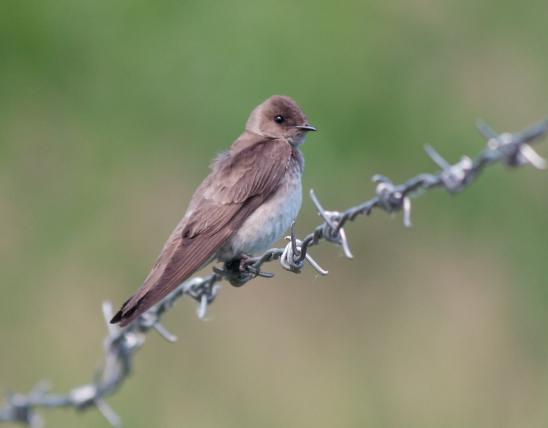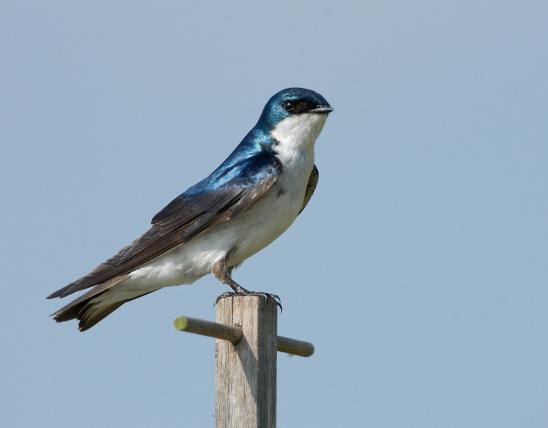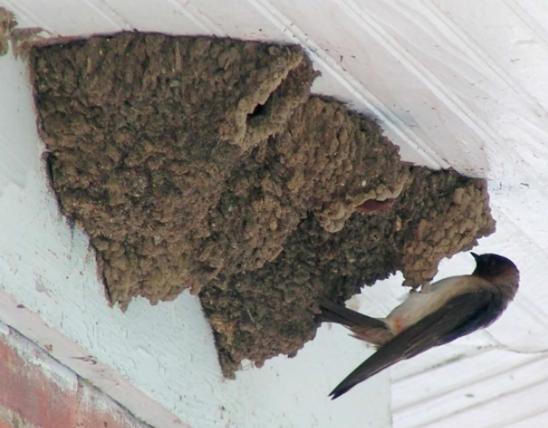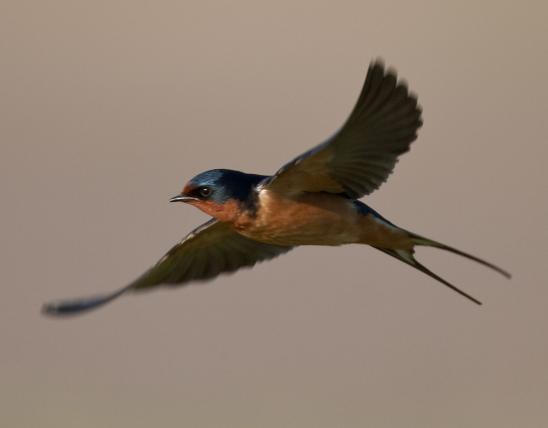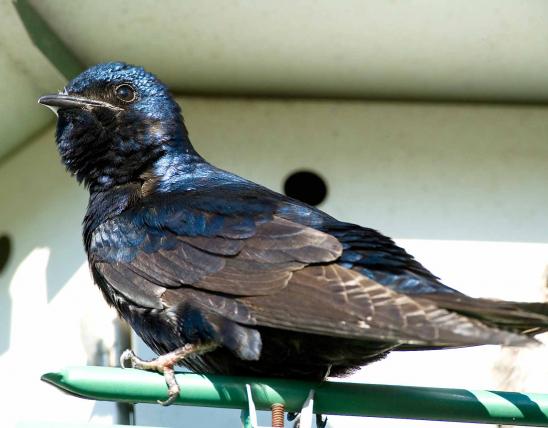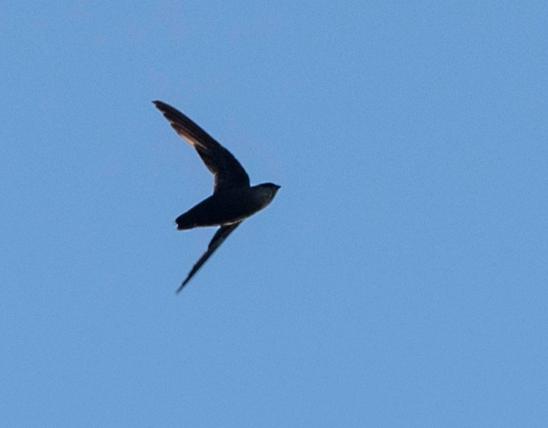
The upperparts of adult bank swallows are dark brown. The underparts are white with a dark brown band across the breast. The throat’s white extends back along the side of the neck and slightly upward. Bank swallows are smaller than the similar northern rough-winged swallow and have short, quick wing strokes in flight. The bill appears tiny. The voice is similar to that of the northern rough-winged swallow. The call is kind of a tchir-tchir or tchip-tchip but is higher pitched and not as harsh. The male’s song is a varied twittery scratchy chatter. In nest colonies, bank swallows make frequent chattering and twittering sounds.
Similar species: Northern rough-winged swallows, which nest in similar places, may be distinguished by noting the characters mentioned above; also, northern rough-winged swallows lack the distinct dark brown band across the breast, and their wings appear to move more slowly, with noticeably long backstrokes.
Length: 5½ inches (tip of bill to tip of tail).
Statewide.
Habitat and Conservation
Usually seen foraging over land and water for insects. As they hunt, they may fly as high as 50 feet in the air. They prefer open areas over water. During migration, bank swallows gather in huge flocks with other swallow species.
Bank swallows, like northern rough-winged swallows and belted kingfishers, nest in holes that they excavate in the steep banks of streams where floodwaters have undercut a riverbank. These vertical banks, often called cutbanks, along streams and rivers are continually being eroded as the stream meanders along. In good years and areas, a nesting colony of these birds will nest successfully, but in some years or locations, water from a flood may undercut the stream bank, especially where vegetation has been removed, and destroy many nests in the colony.
Cutbanks are a natural part of a functioning river system. Historically, our rivers were shallower and wider and meandered in wide curves across the landscape. During floods, the extra water could spread out fairly evenly across the floodplain and create less havoc on the land. Now, many rivers have been straightened and channelized into deeper V-shapes. Artificial stabilization of stream banks, especially when concrete riprap is laid on the shoreline to prevent erosion, typically renders the banks unsuitable for nesting swallows and kingfishers. Unchannelized stretches of streams and rivers are needed to accommodate these species.
Bank swallows and northern rough-winged swallows may utilize other, artificial habitats. Roads that have cut through loess or sand deposits leave a vertical bank in which bank swallows and northern rough-winged swallows excavate nests. This occurs most frequently in northwestern Missouri in the breaks and hills that parallel the Missouri River floodplain.
Bank swallows have been known to excavate nest burrows into the steeply sloped sides of mounds of earth created by bulldozers at construction sites. If the mound is destroyed or disturbed before the young are fledged, it’s a disaster for the breeding pair.
Food
Like other swallows, the bank swallow forages on the wing for flying insects. Bank swallows may forage as individuals or in groups. They are fast, nimble fliers and use their aerodynamic skills to hunt flies, bees, wasps, flying ants, true bugs, dragonflies and damselflies, moths, stoneflies, and other insects in the air.
Status
Locally common summer resident; rare in Ozarks.
The numbers of this species are in steep decline. Populations in North America have plummeted approximately 89 percent since 1970. Although they are still widespread and numerous, their populations have dropped dramatically. Possible reasons include loss of nesting habitat, especially flood and erosion control projects, road construction, river channelization, and anything else that removes or lessens the steep angle of earthen banks or bluffs. These birds need nearly vertical mud or dirt embankments in which to nest. As insectivores, bank swallows may be susceptible to pesticides intended to control insects.
Bank swallows have a Holarctic distribution, occurring all around the Northern Hemisphere. Populations that breed in North America spend winter in South America, and populations that breed in Eurasia overwinter mostly in Africa, migrating over the Saharan desert, the Middle East, or both. Bank swallows have different common names in their different regions. In Europe, the species is called the sand martin. In South America, it is called avión zapador in Spanish and andorinha-do-barranco in Brazilian Portuguese.
Life Cycle
This species nests in holes excavated in vertical alluvial banks along rivers, loess bluffs, cliffs, rock faces created by highway excavation, and crevices on concrete bridges and culverts. Unlike the similar northern rough-winged swallow, bank swallows are gregarious and live in large nesting colonies that can include hundreds of nests. The entrance holes may be only about 1 foot apart.
The soil must be loose enough for the birds to dig into, and the location is usually near a wide-open body of water. They usually excavate their own nest holes. The males dig with their bill, feet, and wings; then the females do most of the nest construction.
The burrows extend about 2 or 3 feet into the bank, and the nest chamber is filled with grasses, leaves, and other soft vegetation. A clutch comprises 3–5 eggs, which are incubated for 13–15 days. After hatching, the young remain in the nest for 18–21 days. There may be 1 or 2 broods. A bank swallow may live to be at least 8 years old.
Bank swallows, being dependent on insects for food, do not arrive in Missouri until insects are becoming active, in the first half of April. Their numbers increase rapidly over the next few weeks, as many bank swallows move through our state on their way further north. Springtime numbers peak in the first half of May, until only our summer resident populations remain. By the middle of August, fall migration is under way, and numbers again increase as they move through our state in huge flocks. By the middle of September, the numbers are dropping as they fly south for the winter, and they are gone in early October. They overwinter in South America.
Human Connections
Birdwatching is challenging, rewarding, and fun, and it gets you outside into nature. If you’re wanting to see bank swallows, go to likely habitats: open water where there are big, vertical banks and bluffs, where their colonies might be located. During migration, look for them in huge mixed-species flocks of swallows. Listen for their two-note calls. Visually, the bank swallows will be the smaller ones with faster, more fluttery wings and the diagnostic brown breast band.
Because people are usually not fond of flying insects, they can appreciate the foraging of swallows, as they help to check populations of flying insects, especially around water.
Human activities that reduce the amount of nesting habitat for bank swallows reduce the populations of these birds.
Ecosystem Connections
Bank swallows nest in the upper third of vertical embankments to avoid predators, to lessen the possibility of a flooded nest, and to have a relatively stable temperature in the nest.
The bank swallow is connected to many kinds of species. It is connected to the flying insects it eats, and its migration timing is centered on their availability. A primary reason why birds migrate in spring is to take advantage of plentiful insects in their summer nesting territory. They can successfully produce more offspring in North America than if they had stayed in their winter territory and competed for insects with other birds. During migration, bank swallows typically flock with other swallows as they travel for many hundreds of miles.
See Habitat and Conservation, above, for comments about their streambank habitat.








About 350 species of birds are likely to be seen in Missouri, though nearly 400 have been recorded within our borders. Most people know a bird when they see one — it has feathers, wings, and a bill. Birds are warm-blooded, and most species can fly. Many migrate hundreds or thousands of miles. Birds lay hard-shelled eggs (often in a nest), and the parents care for the young. Many communicate with songs and calls.






















